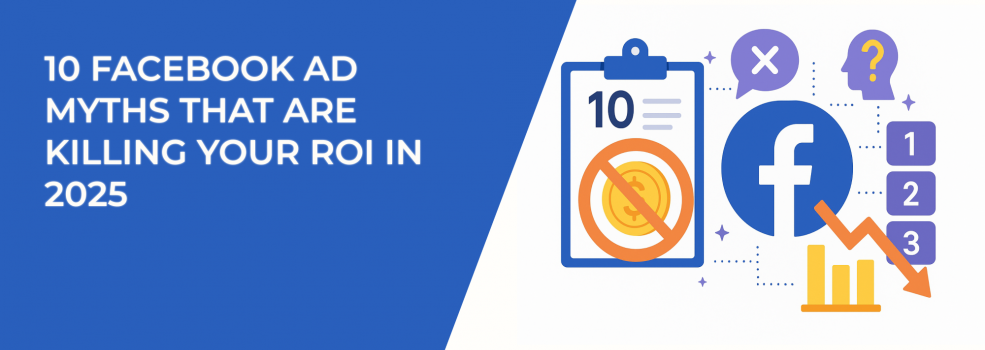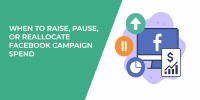Facebook Ads are still one of the most profitable digital marketing tools in 2025. But many advertisers keep making the same mistakes because they believe in myths that no longer apply. These outdated ideas can quietly drain your budget, lower your conversion rates, and stop your campaigns from scaling.
The good news? Once you know what’s holding you back, you can fix it. Let’s look at ten common Facebook ad myths and how they might be hurting your ROI.
1. More Budget Always Means More Results
It’s natural to think that if you spend more, you’ll earn more. Unfortunately, it doesn’t work that way with Facebook Ads. Scaling too quickly often makes things worse instead of better. Costs rise, delivery becomes unstable, and conversions don’t grow at the same pace.
When advertisers scale too fast, they often face:
-
Higher CPMs because the system expands into more expensive placements.
-
Rising CPAs as Facebook tries to find extra conversions in weaker audience segments.
-
Wasted spend before the campaign has proven it can scale efficiently.
If scaling is your challenge, check out The Science of Scaling Facebook Ads Without Killing Performance for step-by-step strategies that keep growth profitable.
2. Broad Targeting Never Works
Many advertisers believe only very narrow audiences produce results. They avoid broad targeting, thinking it wastes money. But in 2025, Facebook’s system often performs better when it has more room to learn.
Broad targeting works well under certain conditions:
-
Your pixel has strong conversion history that guides the algorithm.
-
You’re running Advantage+ campaigns where automation handles delivery.
-
Your creative speaks directly to the right customer, filtering out people who aren’t interested.
Curious about the trade-offs? We cover this in detail in Retargeting vs. Broad Targeting: Which Strategy Drives Better Results?
3. Boosted Posts Are Just as Good as Ads
Boosting posts feels simple and quick, but it’s not a replacement for proper campaigns in Ads Manager. Boosted posts are built for engagement, not for revenue.
They fall short because:
-
You can’t optimize for deeper goals like leads or sales.
-
You lose the ability to properly split test creative variations.
-
Placements and budget controls are limited.
Want to see why boosting often backfires? Read Why You Shouldn’t Boost Facebook Posts (And What to Do Instead).
4. Facebook Ads Don’t Work for B2B
A common misconception is that Facebook only works for consumer brands. But B2B buyers are people, and they scroll Facebook and Instagram just like anyone else. The difference is in how you approach them.
Successful B2B campaigns usually:
-
Offer helpful resources like eBooks, case studies, or webinars.
-
Retarget warm audiences with demo offers or testimonials.
-
Use lookalikes built from CRM or trade show data to expand reach.
Think of a business leader relaxing in the evening. She’s not in “work mode,” but if your ad speaks to a pain point she feels daily, she’ll click. That click may start a valuable sales conversation later.
5. The Algorithm Will Fix Everything
It’s easy to overestimate automation. Many advertisers assume the algorithm can take a weak campaign and make it work. It can’t.
The algorithm can’t save you from:
-
An offer that isn’t compelling.
-
A creative that fails to grab attention.
-
A landing page that loads slowly or confuses users.
Instead, think of the algorithm as an amplifier. It takes strong campaigns and helps them perform even better. But if the foundation is weak, it only speeds up failure.
6. You Need Dozens of Ads to Succeed
More ads don’t always mean more success. In fact, running too many ads at once usually makes performance worse. The budget spreads too thin, and the algorithm doesn’t collect enough data to learn.
A better system looks like this:
-
Start with 3–5 strong ads that show different creative angles.
-
Monitor results and cut ads that underperform quickly.
-
Refresh top ads with small changes (new images or headlines) to keep them alive longer.
This way, each ad gets enough impressions for you to see clear results. Quality always beats quantity when it comes to creative testing.
7. Retargeting Always Works Instantly
Retargeting is powerful, but it doesn’t mean instant sales. Most people don’t convert the first time they see your brand. They need multiple reminders and reasons to trust you.
The best retargeting strategies use a sequence, not a single ad:
-
Show what they looked at, like the product or service page.
-
Build trust by highlighting reviews, case studies, or testimonials.
-
Offer an incentive like a discount or bonus to close the deal.
If you’re just starting, here’s a step-by-step guide: How to Set Up Facebook Retargeting.
8. Higher CTR Means Higher ROI
Many advertisers celebrate high click-through rates, but clicks alone don’t bring revenue. CTR can be misleading if it doesn’t lead to conversions.
High CTR often hides problems like:
-
Clickbait ads that drive the wrong audience.
-
Weak landing pages that cause visitors to bounce.
-
Cheap traffic that never becomes paying customers.
The real measure of success is in metrics tied to business outcomes: cost per acquisition, ROAS, and lifetime value. CTR is useful, but it’s just a signal, not the final score.
For a deeper dive into smarter metrics, see How to Analyze Facebook Ad Performance Beyond CTR and CPC.
9. Video Ads Are Always Better Than Images
Video often gets more attention in the industry, but that doesn’t mean it’s always the top performer. Sometimes static images deliver stronger results because they’re faster to process.
Video works well when:
-
You need to explain a complex product.
-
You’re building brand awareness through storytelling.
-
You’re retargeting people who already know you.
Images often win when:
-
Your offer is simple and direct.
-
Users are scrolling fast on mobile devices.
-
You want to test messaging quickly.
The right approach is to test both. Don’t assume video automatically beats images — let your audience decide.
10. Once Ads Work, You Can “Set and Forget”
One of the most expensive myths is believing you can leave a winning campaign running forever. Even strong ads fade over time. Audiences get tired, competitors adjust bids, and seasonal trends change.
Here’s why campaigns lose power if left alone:
-
Ad fatigue: People ignore ads they’ve seen too often.
-
Rising competition: New advertisers push auction prices higher.
-
Market shifts: What worked in Q1 may not work in Q3.
The solution is ongoing optimization. Refresh creatives every month or so, test new copy, and monitor frequency. Treat ads like living systems that need regular care.
If you’re noticing performance drop-offs, read Ad Fatigue on Facebook: How to Spot It Early and Fix It Fast.
Final Thoughts
These myths are still common in 2025, and they cost advertisers real money. Believing them means chasing vanity metrics, scaling campaigns in the wrong way, or expecting quick results where patience is needed.
The advertisers who succeed treat Facebook Ads as an ongoing process. They test carefully, optimize consistently, and focus on the metrics that matter for growth. Cut through the noise, avoid these traps, and your ROI will thank you.

